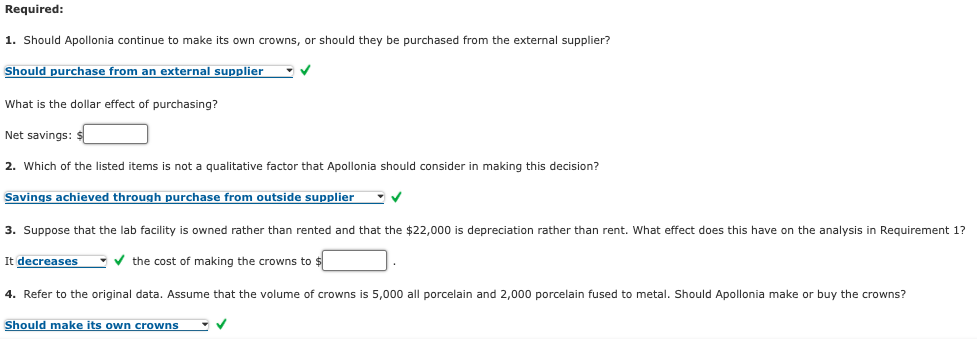Make-or-Buy, Traditional Analysis, Qualitative Considerations Apollonia Dental Services is part of an HMO that operates in a large metropolitan area. Currently, Apollonia has its own dental laboratory to produce two varieties of porcelain crowns—all porcelain and porcelain fused to metal. The unit costs to produce the crowns are as follows: All Porcelain Porcelain Fused to Metal Direct materials $190 $80 Direct labor 50 20 Variable overhead 25 5 Fixed overhead 60 40 Total $325 $145 Fixed overhead is detailed as follows: Salary (supervisor) $30,000 Depreciation 8,000 Rent (lab facility) 22,000 Overhead is applied on the basis of direct labor hours. The rates above were computed using 8,000 direct labor hours. No significant non-unit-level overhead costs are incurred. A local dental laboratory has offered to supply Apollonia all the crowns it needs. Its price is $265 for all-porcelain crowns and $145 for porcelain-fused-to-metal crowns; however, the offer is conditional on supplying both types of crowns—it will not supply just one type for the price indicated. If the offer is accepted, the equipment used by Apollonia’s laboratory would be scrapped (it is old and has no market value), and the lab facility would be closed. Apollonia uses 2,500 all-porcelain crowns and 1,000 porcelain-fused-to-metal crowns per year.
Variance Analysis
In layman's terms, variance analysis is an analysis of a difference between planned and actual behavior. Variance analysis is mainly used by the companies to maintain a control over a business. After analyzing differences, companies find the reasons for the variance so that the necessary steps should be taken to correct that variance.
Standard Costing
The standard cost system is the expected cost per unit product manufactured and it helps in estimating the deviations and controlling them as well as fixing the selling price of the product. For example, it helps to plan the cost for the coming year on the various expenses.
Make-or-Buy, Traditional Analysis, Qualitative Considerations
Apollonia Dental Services is part of an HMO that operates in a large metropolitan area. Currently, Apollonia has its own dental laboratory to produce two varieties of porcelain crowns—all porcelain and porcelain fused to metal. The unit costs to produce the crowns are as follows:
| All Porcelain | Porcelain Fused to Metal |
||||||
| Direct materials | $190 | $80 | |||||
| Direct labor | 50 | 20 | |||||
| Variable |
25 | 5 | |||||
| Fixed overhead | 60 | 40 | |||||
| Total | $325 | $145 |
Fixed overhead is detailed as follows:
| Salary (supervisor) | $30,000 |
| 8,000 | |
| Rent (lab facility) | 22,000 |
Overhead is applied on the basis of direct labor hours. The rates above were computed using 8,000 direct labor hours. No significant non-unit-level overhead costs are incurred.
A local dental laboratory has offered to supply Apollonia all the crowns it needs. Its price is $265 for all-porcelain crowns and $145 for porcelain-fused-to-metal crowns; however, the offer is conditional on supplying both types of crowns—it will not supply just one type for the price indicated. If the offer is accepted, the equipment used by Apollonia’s laboratory would be scrapped (it is old and has no market value), and the lab facility would be closed. Apollonia uses 2,500 all-porcelain crowns and 1,000 porcelain-fused-to-metal crowns per year.

Trending now
This is a popular solution!
Step by step
Solved in 2 steps








